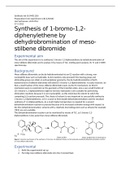The drug cannabis might be a pancreatic cancer treatment.
Abstract
Pancreatic cancer is one of the major causes of death and the treatment of pancreatic
cancer, such as chemotherapy, has side effects. This is the reason why there is a need for
medication that reduces the pancreatic cancers deaths and the side effects of cancer
therapies in general. The effects of cannabis on the pancreas have been studied and the
result is that cannabis affects the pancreatic cancer cells while the normal pancreatic cells
are not influenced. Cannabis also has a positive impact on the side effects of other cancer
treatments. Naturally, cannabis does have negative side effects itself, which are, for
example: hallucinations. Cannabis is a good treatment for pancreatic cancer but it has to be
combined with other treatments to attack the cancer cells at different ways.
Introduction
Cancer is the number two major disease that leads to death. Cancer itself and treatments for
cancer, for example chemotherapy, often have many side effects such as nausea, fatigue,
hair loss, loss of appetite and lethargy. These side effects can be treated with the active
substances of the drug cannabis (Anderson SP, n.d. 2019). Major active substances of
cannabis are THC, cannabinoids and endocannabinoids (Sharafi, He, & Nikfarjam, 2019, pp.
1-7). It is important that the treatment with cannabis has a positive effect on cancer, and not
only to the side effects of cancer treatments, such as getting nauseous. This is important
because the cancer itself needs to be treated. Studies in the past have shown that
cannabinoids, the active substance of cannabis, can decrease the size of tumors and inhibit
blood vessel growth (Sharafi, He, & Nikfarjam, 2019, pp. 1-7). Inhibition of blood vessel
growth reduces blood supply to the cancer cells, and diminishes their growth-rate. Other
studies have shown that other active substances in cannabis, the endocannabinoids,
influence the inhibition and apoptosis of the tumor cell and the metastasis (Yasmin-Karim S,
n.d. 2018, pp.1-8). Cannabis may specifically be a treatment for pancreatic cancer, as the
pancreas has receptors to which cannabis’ substances can bind without affecting normal
pancreatic cells. In vivo studies with the use of cannabis were done on a small scale showed
that besides cannabis as a treatment, chemotherapy and radiotherapy were still necessary
(Yasmin-Karim S, n.d. 2018, pp.1-8). Therefore, it is not known if the cannabis really has
effect on the cancer itself, without the help of chemo- and radiotherapy (Yasmin-Karim S,
n.d. 2018, pp.1-8). This research will study the effects of cannabis on pancreatic cancer. To
answer this question, the effect of the cannabis’ active substances on several pathways of
the cell will be studied. After that, it will be examined if cannabis itself has any negative side
effects.
Body
Cannabis has effects on pancreatic cells.
Cannabis consists of active substances that have an effect on pancreatic cancer cells. In this
paragraph, it will be discussed in what ways the cannabis has effect on the pancreatic cells.
The two main substances of cannabis are tetrahydrocannabinol (THC) and cannabinoids
and these substances have a direct and an indirect impact on receptors of the cell
membranes of pancreatic cells. The three most important receptors are the cannabinoid
receptor-1 (CB1), cannabinoid receptor-2 (CB2) and G-protein-coupled receptor 55 (GPR55)
(Sharafi, He, & Nikfarjam, 2019, pp. 1-7). Direct ways of stimulating the receptors is by the
binding of cannabinoids to the receptors. For example endocannabinoids AEA and 2-AG or
agonists of the receptors bind to the receptors. CB1s agonist has inhibiting effects on tumor-
growth and it affects transcribed genes, but when THC stimulates CB1 it has a psychological
Abstract
Pancreatic cancer is one of the major causes of death and the treatment of pancreatic
cancer, such as chemotherapy, has side effects. This is the reason why there is a need for
medication that reduces the pancreatic cancers deaths and the side effects of cancer
therapies in general. The effects of cannabis on the pancreas have been studied and the
result is that cannabis affects the pancreatic cancer cells while the normal pancreatic cells
are not influenced. Cannabis also has a positive impact on the side effects of other cancer
treatments. Naturally, cannabis does have negative side effects itself, which are, for
example: hallucinations. Cannabis is a good treatment for pancreatic cancer but it has to be
combined with other treatments to attack the cancer cells at different ways.
Introduction
Cancer is the number two major disease that leads to death. Cancer itself and treatments for
cancer, for example chemotherapy, often have many side effects such as nausea, fatigue,
hair loss, loss of appetite and lethargy. These side effects can be treated with the active
substances of the drug cannabis (Anderson SP, n.d. 2019). Major active substances of
cannabis are THC, cannabinoids and endocannabinoids (Sharafi, He, & Nikfarjam, 2019, pp.
1-7). It is important that the treatment with cannabis has a positive effect on cancer, and not
only to the side effects of cancer treatments, such as getting nauseous. This is important
because the cancer itself needs to be treated. Studies in the past have shown that
cannabinoids, the active substance of cannabis, can decrease the size of tumors and inhibit
blood vessel growth (Sharafi, He, & Nikfarjam, 2019, pp. 1-7). Inhibition of blood vessel
growth reduces blood supply to the cancer cells, and diminishes their growth-rate. Other
studies have shown that other active substances in cannabis, the endocannabinoids,
influence the inhibition and apoptosis of the tumor cell and the metastasis (Yasmin-Karim S,
n.d. 2018, pp.1-8). Cannabis may specifically be a treatment for pancreatic cancer, as the
pancreas has receptors to which cannabis’ substances can bind without affecting normal
pancreatic cells. In vivo studies with the use of cannabis were done on a small scale showed
that besides cannabis as a treatment, chemotherapy and radiotherapy were still necessary
(Yasmin-Karim S, n.d. 2018, pp.1-8). Therefore, it is not known if the cannabis really has
effect on the cancer itself, without the help of chemo- and radiotherapy (Yasmin-Karim S,
n.d. 2018, pp.1-8). This research will study the effects of cannabis on pancreatic cancer. To
answer this question, the effect of the cannabis’ active substances on several pathways of
the cell will be studied. After that, it will be examined if cannabis itself has any negative side
effects.
Body
Cannabis has effects on pancreatic cells.
Cannabis consists of active substances that have an effect on pancreatic cancer cells. In this
paragraph, it will be discussed in what ways the cannabis has effect on the pancreatic cells.
The two main substances of cannabis are tetrahydrocannabinol (THC) and cannabinoids
and these substances have a direct and an indirect impact on receptors of the cell
membranes of pancreatic cells. The three most important receptors are the cannabinoid
receptor-1 (CB1), cannabinoid receptor-2 (CB2) and G-protein-coupled receptor 55 (GPR55)
(Sharafi, He, & Nikfarjam, 2019, pp. 1-7). Direct ways of stimulating the receptors is by the
binding of cannabinoids to the receptors. For example endocannabinoids AEA and 2-AG or
agonists of the receptors bind to the receptors. CB1s agonist has inhibiting effects on tumor-
growth and it affects transcribed genes, but when THC stimulates CB1 it has a psychological











